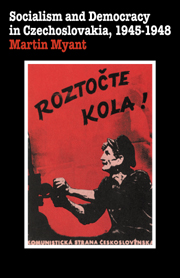Book contents
- Frontmatter
- Contents
- Acknowledgements
- Abbreviations
- Introduction
- 1 The development of the Communist Party of Czechoslovakia
- 2 War and occupation
- 3 The national revolution
- 4 The national revolution in Slovakia
- 5 Czech political parties
- 6 The Gottwald government
- 7 Deepening divisions
- 8 Prelude to February
- 9 The February crisis
- 10 Post-February Czechoslovakia
- Notes
- Bibliography
- Index
4 - The national revolution in Slovakia
Published online by Cambridge University Press: 07 October 2011
- Frontmatter
- Contents
- Acknowledgements
- Abbreviations
- Introduction
- 1 The development of the Communist Party of Czechoslovakia
- 2 War and occupation
- 3 The national revolution
- 4 The national revolution in Slovakia
- 5 Czech political parties
- 6 The Gottwald government
- 7 Deepening divisions
- 8 Prelude to February
- 9 The February crisis
- 10 Post-February Czechoslovakia
- Notes
- Bibliography
- Index
Summary
Slovakia was not at the centre of attention throughout the first year after liberation and its importance for the future of the whole state was only demonstrated by the Democratic Party's sweeping electoral victory. This followed a period of development in Slovakia which was in many ways different from that in the Czech lands. Moreover, Communist policy, decided by the KSČ leadership first in Moscow and then in Prague, was not based on an appreciation of the specificity of Slovakia's development and that greatly aggravated the difficulties the KSS was to face.
Differences between the two parts of the republic were revealed at the time of liberation as, although Communists often took the initiative in establishing National Committees in Slovakia too, the genuine breadth and depth of their influence remains unclear. Illegal activity had often amounted only to small groups in towns which then emerged to establish the new organs of power: much of the countryside remained sympathetic to the Slovak state to the end. Aware of the presence of the Red Army and the NKVD, Slovak Communists were often content to consolidate their strength by avoiding free elections to National Committees in which they would probably have been defeated. In some places, however, they were unable to gain any representation at all, so that, over 14 Districts in liberated Eastern Slovakia on 8 April 1945, Local National Committees contained 1765 Communists, 1404 Democrats and 862 non-party members.
The worst case was in Michalovce where the NKVD was accused of removing a non-Communist District National Committee.
- Type
- Chapter
- Information
- Socialism and Democracy in Czechoslovakia1945-1948, pp. 91 - 104Publisher: Cambridge University PressPrint publication year: 1981



